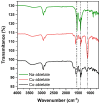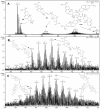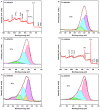Copper(II) and Cobalt(II) Complexes Based on Abietate Ligands from Pinus Resin: Synthesis, Characterization and Their Antibacterial and Antiviral Activity against SARS-CoV-2
- PMID: 37049296
- PMCID: PMC10096983
- DOI: 10.3390/nano13071202
Copper(II) and Cobalt(II) Complexes Based on Abietate Ligands from Pinus Resin: Synthesis, Characterization and Their Antibacterial and Antiviral Activity against SARS-CoV-2
Abstract
Co-abietate and Cu-abietate complexes were obtained by a low-cost and eco-friendly route. The synthesis process used Pinus elliottii resin and an aqueous solution of CuSO4/CoSO4 at a mild temperature (80 °C) without organic solvents. The obtained complexes are functional pigments for commercial architectural paints with antipathogenic activity. The pigments were characterized by Fourier-transform infrared spectroscopy (FTIR), mass spectrometry (MS), thermogravimetry (TG), near-edge X-ray absorption fine structure (NEXAFS), X-ray photoelectron spectroscopy (XPS), scanning electron microscopy (SEM), and colorimetric analysis. In addition, the antibacterial efficiency was evaluated using the minimum inhibitory concentration (MIC) test, and the antiviral tests followed an adaptation of the ISO 21702:2019 guideline. Finally, virus inactivation was measured using the RT-PCR protocol using 10% (w/w) of abietate complex in commercial white paint. The Co-abietate and Cu-abietate showed inactivation of >4 log against SARS-CoV-2 and a MIC value of 4.50 µg·mL-1 against both bacteria Staphylococcus aureus (S. aureus) and Escherichia coli (E. coli). The results suggest that the obtained Co-abietate and Cu-abietate complexes could be applied as pigments in architectural paints for healthcare centers, homes, and public places.
Keywords: SARS-CoV-2; abietic acid; antimicrobial pigments; antiviral surfaces; natural resin.
Conflict of interest statement
The authors declare no conflict of interest.
Figures








Similar articles
-
Eco-Friendly Synthesis of an Oxovanadium(IV)-bis(abietate) Complex with Antimicrobial Action.Molecules. 2022 Oct 7;27(19):6679. doi: 10.3390/molecules27196679. Molecules. 2022. PMID: 36235216 Free PMC article.
-
Experimental data for green synthesis of Zn-abietate complex from natural resin.Data Brief. 2021 Dec 31;40:107776. doi: 10.1016/j.dib.2021.107776. eCollection 2022 Feb. Data Brief. 2021. PMID: 35028348 Free PMC article.
-
Green Synthesis of Na abietate Obtained from the Salification of Pinus elliottii Resin with Promising Antimicrobial Action.Antibiotics (Basel). 2023 Mar 4;12(3):514. doi: 10.3390/antibiotics12030514. Antibiotics (Basel). 2023. PMID: 36978381 Free PMC article.
-
Synthesis of silver abietate as an antibacterial agent for textile applications.Bioinorg Chem Appl. 2015;2015:215354. doi: 10.1155/2015/215354. Epub 2015 Feb 25. Bioinorg Chem Appl. 2015. PMID: 25810694 Free PMC article.
-
Evaluating the capabilities of DART-MS compared to FTIR spectroscopy and SEM-EDS for the analysis of architectural paint mixtures.Forensic Sci Int. 2025 Mar;368:112405. doi: 10.1016/j.forsciint.2025.112405. Epub 2025 Feb 10. Forensic Sci Int. 2025. PMID: 39961272
References
-
- Farhadian S., Heidari-Soureshjani E., Hashemi-Shahraki F., Hasanpour-Dehkordi A., Uversky V.N., Shirani M., Shareghi B., Sadeghi M., Pirali E., Hadi-Alijanvand S. Identification of SARS-CoV-2 Surface Therapeutic Targets and Drugs Using Molecular Modeling Methods for Inhibition of the Virus Entry. J. Mol. Struct. 2022;1256:132488. doi: 10.1016/j.molstruc.2022.132488. - DOI - PMC - PubMed
LinkOut - more resources
Full Text Sources
Miscellaneous

